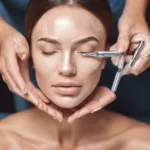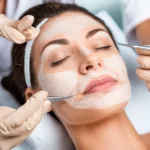22 November 2023
Discover the benefits, risks, and procedure of dermaplaning, a popular skincare treatment for achieving smoother and brighter skin.
In the pursuit of flawless and youthful skin, individuals are turning to dermaplaning, a minimally invasive procedure that promises to reveal brighter and smoother skin by shaving away the top layers. This article explores the ins and outs of dermaplaning, including its benefits, risks, and the steps involved in the procedure. Whether you’re looking to reduce acne scars, exfoliate dull skin, or remove unwanted hair, dermaplaning may be the solution you’ve been searching for.
What is Dermaplaning?
Dermaplaning involves the use of a handheld surgical device called a dermatome, which resembles a scalpel, to gently shave off thin layers of skin and hair. This deep exfoliating method can be performed on a small problem area or the entire face, depending on the individual’s needs. It is commonly used to reduce the appearance of fine lines, wrinkles, and acne scars.
Dermaplaning vs. Dermabrasion vs. Microdermabrasion: What’s the Difference?
While dermaplaning, dermabrasion, and microdermabrasion all involve removing the top layers of skin, they differ in terms of tools used and the depth of exfoliation. Microdermabrasion sprays microcrystals or uses a diamond-tipped device to remove dead skin cells, followed by suctioning. Dermabrasion employs an electric rotating brush to remove layers of skin, resulting in more dramatic results but also more invasiveness. Dermaplaning, on the other hand, utilizes a scalpel-like dermatome for deeper exfoliation and hair removal.
Benefits of Dermaplaning
Dermaplaning offers several potential benefits, including reducing the appearance of fine lines, minimizing acne scars and pitted skin, brightening dull and dry skin, removing vellus hair (commonly known as “peach fuzz”), improving skin texture, treating sun-damaged skin, allowing for deeper absorption of skincare products, and prepping the skin for other treatments or procedures.
Who is Dermaplaning Right For?
Dermaplaning is suitable for almost anyone looking to improve their skin’s texture and appearance. Individuals with sun-damaged skin, signs of aging, or certain skin conditions like rosacea may find dermaplaning particularly beneficial. However, those with active acne breakouts, cold sores, skin rashes, burns, moles, or skin tags should avoid the procedure.
What Happens Before Dermaplaning?
Before a dermaplaning session, a consultation with a dermatologist or aesthetician is essential. During this discussion, goals for the session are established, and any potential risks or side effects are explained. Patients may be asked to cleanse their face, remove makeup and skincare products, and avoid certain medications in preparation for the procedure.
What Happens During Dermaplaning?
During a dermaplaning session, a numbing cream or anesthesia may be applied to reduce discomfort. The dermatome is then used at an angle to gently remove the top layers of skin. While the procedure is typically painless, patients may feel some pressure. The duration of a dermaplaning session can range from minutes to an hour.
What Happens After Dermaplaning?
After the procedure, skincare products may be applied to enhance absorption. Visible results are immediate, but patients may experience slight redness or sensitivity, which can fade within three months.
What Are the Risks of Dermaplaning?
Dermaplaning is generally safe, but there are potential risks. These include scarring, nicks and cuts, fever blisters, skin irritation, and thickened skin. However, these risks are relatively rare.
Do You Need Multiple Dermaplaning Procedures?
Dermaplaning results are not permanent. Hair removal results typically last several weeks before regrowth. To maintain ongoing improvements in skin texture and appearance, many individuals opt for monthly dermaplaning sessions.
Conclusion:
Dermaplaning offers a non-invasive solution for individuals seeking smoother, brighter, and more youthful-looking skin. With its potential benefits in reducing acne scars, exfoliating dull skin, and removing unwanted hair, dermaplaning has gained popularity in the realm of skincare treatments. While risks exist, they are minimal when performed by a trained professional. If you’re considering dermaplaning, consult with a dermatologist to determine if this procedure is right for you.



